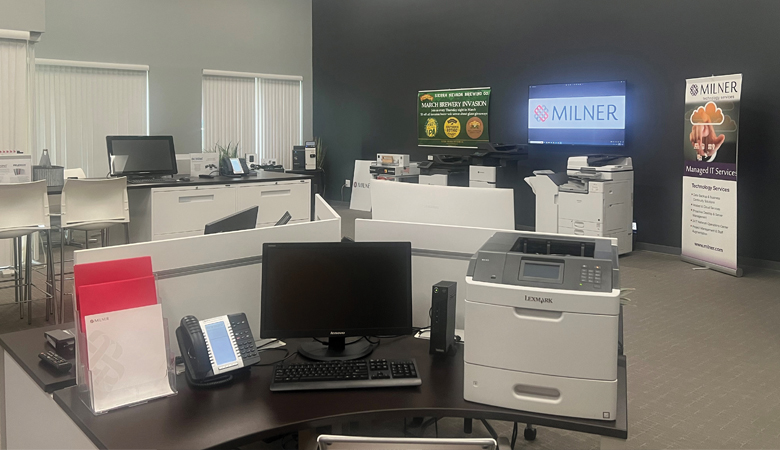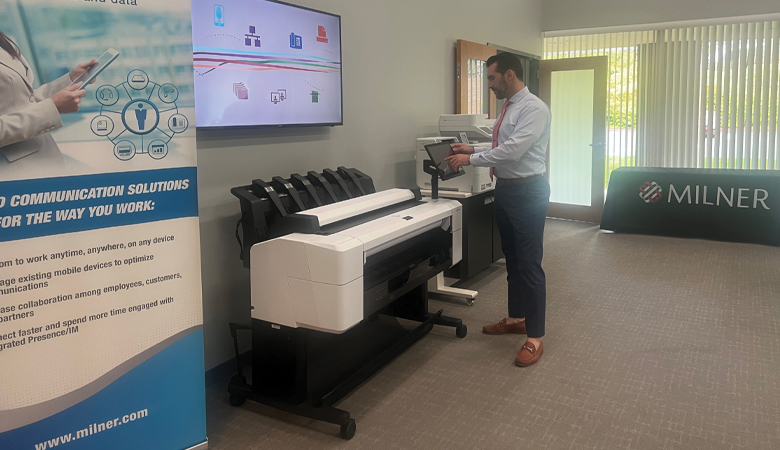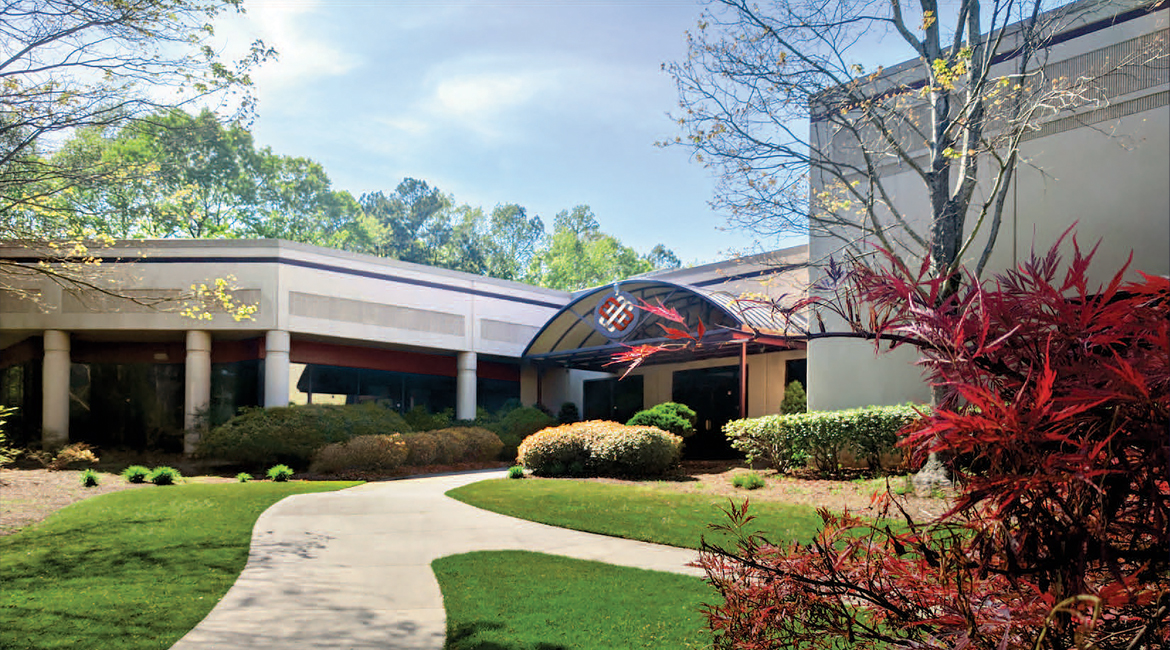President Tom McMahon offers a glimpse into the dealership’s past, present, and future.

Queue The Twilight Zone theme music. Coincidence or not? Tom McMahon, current president of Milner with multiple locations scattered across Georgia, Florida, South Carolina, New Jersey, and New York, started in the office technology industry in White Plains, New York, in 1987, selling for Harris 3M, which would later become Lanier. That was the same year Milner opened its doors as a copier dealer in Atlanta and Palm Beach, Florida. Want another coincidence? Dusty Milner, the founder of Milner, was the grandson of Hicks Lanier, who started a business in 1934 that would eventually become Lanier Worldwide and the office technology company that was acquired by Ricoh in 2001.

Tom McMahon
But before that happened, Dusty’s dad, who was working for Lanier and on the verge of retirement, negotiated a deal with Lanier Worldwide to take over the Atlanta and Palm Beach, Florida, operations and create a new business. That simply involved removing the Lanier sign from those two locations and replacing it with a Milner sign. That brings us to the present day, 37 years later, with McMahon, who joined the company in 1998, at the helm and the dealership flourishing.
Milner’s Upward Mobility
These are boom times for Milner. Its fiscal year runs from September through August. When I interviewed McMahon, the dealership was in the middle of its 2024 fiscal year. “In terms of our growth, it’s been really, really good,” he observed. “Our North Carolina operation is up 35%, our Florida operation is just under 20%, and Atlanta is shy of $12 million.”

Milner’s Raleigh, North Carolina, showroom.
The secret to Milner’s success, according to McMahon, is more than protecting its base. “That’s important, but we’ve been successful in finding new business and stealing business from our direct competitors, the manufacturers.”
Another contributor to this scenario was the pandemic. “During COVID, they put much of their sales forces to sleep,” observed McMahon. “They furloughed them, people left, and they really didn’t have a strategy. Once you pour cold water on an engine while it’s hot, it takes a long time to get it back up to steam again. We are benefiting from that directly. Although they’ll never admit it, they’re just not as aggressive as we were.”
Another factor contributing to growth during the pandemic is that it was business as usual for Milner’s locations in the Southeastern United States, where COVID-19 restrictions were less stringent than in the Northeast.

The Raleigh showroom.
Milner’s strength is in what McMahon calls the mini-major segment, which has taken the place of organizations that typically acquire one to 50 machines. “We’re also looking at the post-COVID boom in this industry in terms of the leases from 2018 and 2019, which are coming up for renewal in 2023 and 2024,” he said. Whether it was Milner upgrading their equipment or a competitor’s, no one had called on those customers for a while and Milner benefited from that.
McMahon sees that dynamic tapering off on the office imaging side of the business, leading to a focus on organic growth. “We must keep bringing on new customers because our traditional office print customers are printing less,” he observed. “They just flat out are.”
Seventy-four percent of Milner’s total revenue comes from office imaging (copiers, printers, etc.), 19% from traditional IT, and the rest from other segments such as software and phone systems. Even though customers are printing less, this year, Milner’s office imaging business is growing faster than the IT business, which McMahon said was a little surprising because the IT business, which is still strong, had been growing “like a weed” prior to then.
On the imaging side of the business, Milner sells Ricoh, Konica Minolta, HP, and Lexmark. He described them as all very good vendors. “What I find is most of the people do not even care,” he observed, referring to the name on the box. “They’re buying Milner, or they’re buying POA, or they’re buying Atlantic, or they’re buying…”

Milner also sells wide format.
With vendors such as Ricoh and Konica Minolta, production print represents a strong segment for Milner, which, up until recently, was one of Ricoh’s top 10 production print dealers. As of today, it’s 11th or 12th, still not a bad position.
Milner has been in the phone business since the early 1980s, what McMahon described as “a traditional on-prem, heavy gear, in-your-face phone company.” It also offers unified communications through Intermedia Cloud Communications, which it sells as its own hosted product. “Our go-to-market strategy is selling a total solution,” emphasized McMahon.
Milner and Managed IT
Based on what’s happening elsewhere in the industry regarding clicks and the evolution of technology in the channel, McMahon sees Milner’s IT and cybersecurity businesses eventually outpacing imaging.
The company entered the managed IT business in 2008. McMahon remembers the moment well. It was during the financial crisis, and he had to present at Milner’s annual board meeting. “One of the guys on our board goes, ‘Is there even going to be a 2009?’” recalled McMahon. “So, I went to Mr. Milner and said, listen, we need to get into the IT business. And he said, ‘What do you know about the IT business?’ I said, I know how to spell it, and I know that we’re in this battle with outside IT providers and our customers…”
With the digital revolution heating up and more devices connected, McMahon understood that Milner had to be directly involved in connecting its customers’ equipment. Doing that would reduce issues customers were having with outside IT companies blaming Milner for connectivity problems and Milner blaming those outside IT companies, leaving the customer caught in the middle. McMahon interviewed various IT companies, found a small one, and told the owner, “We’re going to be your only customer, resell your services, help you grow, and guarantee payment.”
Eventually, Milner acquired that IT company. “It really made the copier and print business so much easier because the level of response that you’re held to is so much higher than in the traditional office imaging space,” said McMahon.
Three years ago, Milner entered the managed security space. “It’s a very fast-growing space for us; however, there’s a whole other level,” said McMahon. “You need to bring your A-game when you’re in managed security because there’s a lot at stake. There’s a lot of profit and margin, but you need the best people, and you need to make sure that you respond [the right] way when there is an incident, and there will be an incident.”
He shared a story of a large customer who had an incident, which Milner responded to in the right way. McMahon had to get on the phone with the customer’s CEO, their legal counsel, the legal counsel for their insurance company, and the insurance company’s forensics person. “You have to be really careful how you answer questions because the reason the insurance company is on that call is it doesn’t want to pay, and they want to figure out how you messed up,” noted McMahon. “I’m happy to say that we were prepared, and we got a thumbs up from the insurance company. That helped us propel our business even more.”
Looking Ahead
Milner’s four main focuses are production print, the phone business, managed print services, and cybersecurity. “That doesn’t mean we’re not focusing on office imaging, but that’s taking care of itself,” observed McMahon. “We’re committed to growing this business and expanding into new markets.”
After a year of organic growth, this year’s focus for Milner is growing its business in the Northeast and expanding its footprint in existing markets. “That’s a big priority for us,” said McMahon. “We are looking to acquire other dealers. We’re negotiating with several to fold them within our footprint. Those are dealers that have come to us, or we’ve gone to them and said, listen, you’d be good joining the group, because we’re not private equity and a manufacturer does not own us. There’s a family that owns the business that’s committed to being in this business for the long term.”
After 36 years in the business, McMahon still loves what he does. “I’m more excited Sunday night to get to work on Monday morning than when I started in this business on July 27, 1987. I love the people I work with and spend more time with them than with my family, and it’s an exciting time.”
He recalled how the industry has survived many challenges over the past 37 years. “During my first week in the business, they had the stock market crash of 1987. There have been wars, the Great Recession, the pandemic, and the channel and the business just keep surviving and thriving. With the disruption in the market now, people’s buying habits changing, the influx of new technologies, IT solutions, et cetera, print remains very stable.”
He added, “For some reason, we just seem to get through it, and we keep evolving. I’m very bullish about the future. Milner is looking to expand, and we’re attracting the right kind of people. We want to grow the business profitably, and we’re taking advantage of the opportunities presented to us.”



